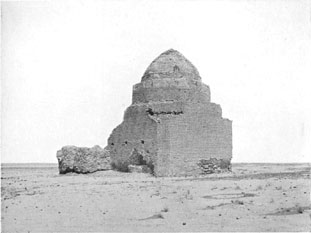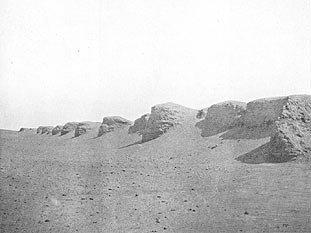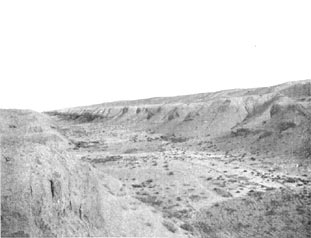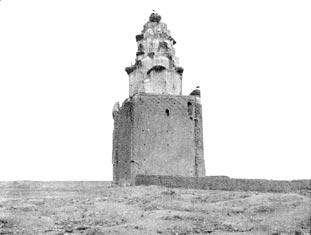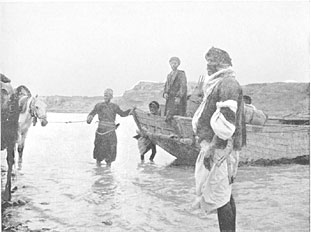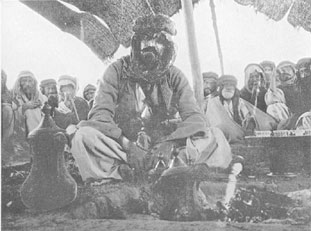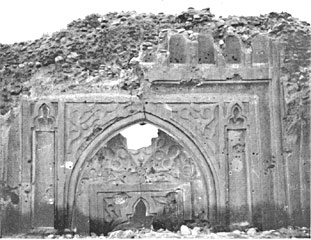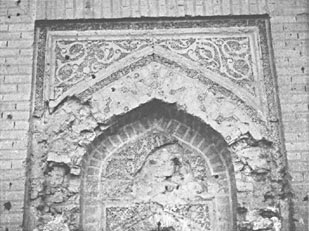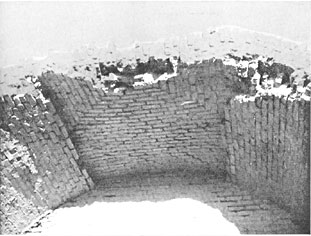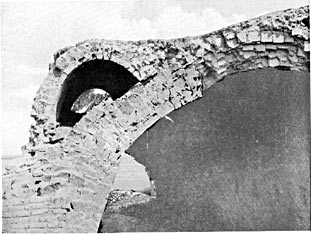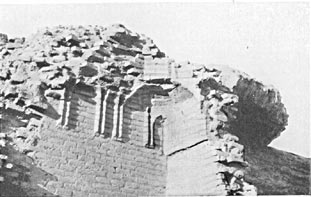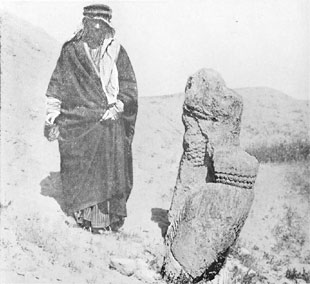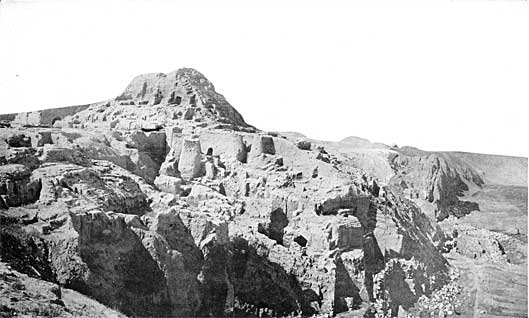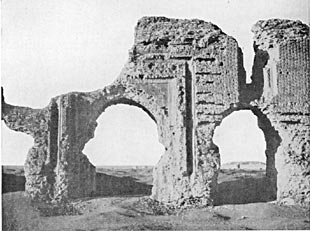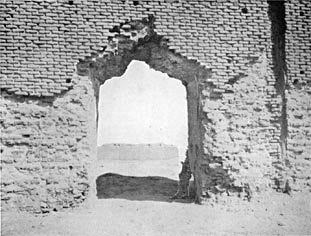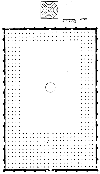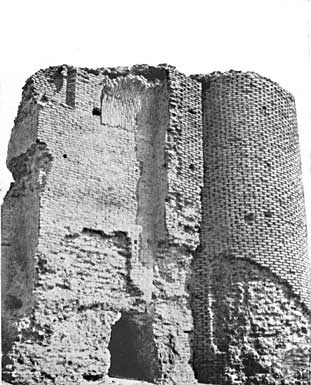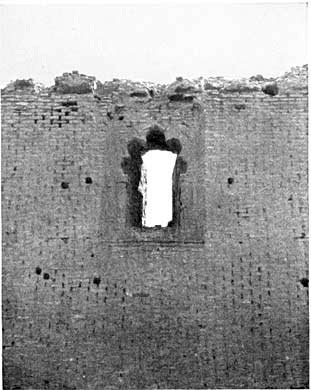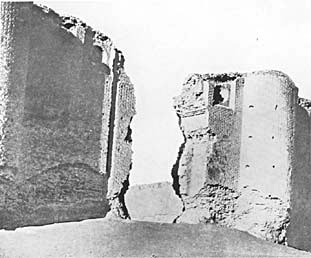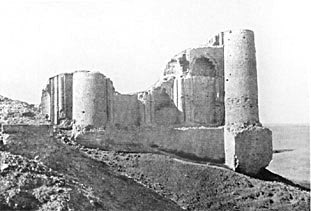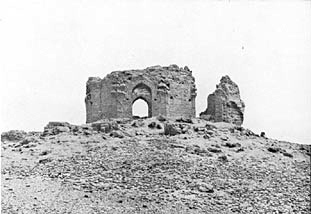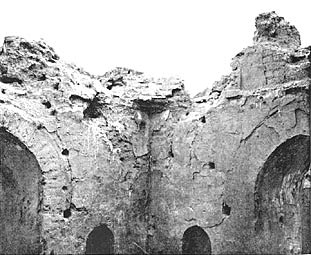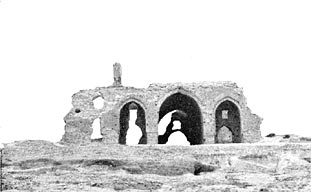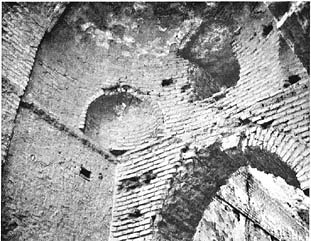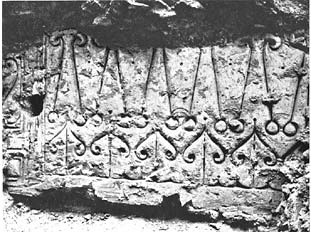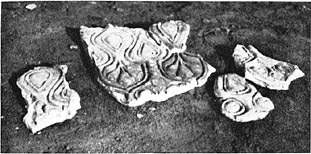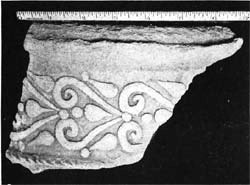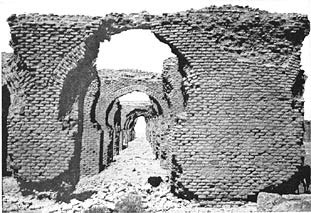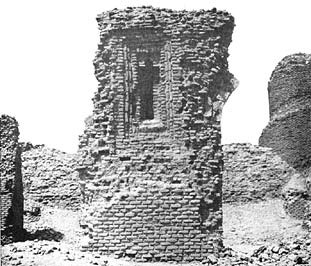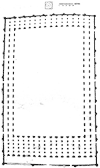/ p.198 /
CHAPTER VI
BAGHDÂD to MÔSUL
April 12—April 28
WE left Baghdâd on the wings of a strong south wind. My kind host mounted and rode with me for the first half-hour, and we parted in a dust-storm at the upper bridge. When he was gone, I joined my servants, who welcomed me with solicitous inquiries as to how I had passed my time in the city of Baghdâd. I replied that I had passed every moment enjoyably, and that I trusted that they had been equally well pleased. Fattûh hastened to satisfy me on this head. His friends had vied with one another in providing entertainments, and he and the muleteers had been plunged into a vortex of luncheon and dinner parties.
"And last night," concluded Fattûh, "we supped at the Kâzimein."
*You had far to go," said I. "How did you get back in the darkness?"
"Effendim," began Fattûh — but I cannot remember his exact words, for they were at once absorbed into the recollection of a more famous utterance; the upshot of his explanation was, that the rule laid down by Mr. Jorrocks is observed in Baghdâd, with one exception. Where you dines you sleeps, but you do not have breakfast; you rise at 4 a.m. and hurry home, since it would be an infringement of the social law to appear to expect that your host should provide the morning meal.
We were riding by a narrow path along the top of the sidd, the steep embankment of the Tigris, and as we went, the wind grew more and more violent and the difficulty of preserving a foothold on that knife-edge of a road greater and greater. The loaded pack animals were ever struggling away / MUSHEIDAH p.199 / from an imminent brink, towards which the following wind buffeted them, first on one side and then on the other, according to the windings of the path. During the course of the day one of the horses, unwarily presenting a full flank to the blast, was swept off its feet and rolled into a cornfield, but by good luck this accident occurred after we had descended from the sidd on to level ground. The dust was so intolerable that we welcomed the heavy raindrops which presently came driving down upon the storm; but they could not pacify the unruly earth, and dust and rain together formed an atmospheric mud ocean, churned by the wind into whirlpools and breakers. Never have I ridden through such a hurricane. Six hours from the bridge we reached the khân of Musheidah1
---------------------------
1 Kiepert calls if Khân et Tarniyeh.
---------------------------
where we had intended to pitch camp. No tent ropes would have held for half-an-hour in that wind, if it had been possible to unfurl the tents, which it was not, and we rode into the khân to seek a lodging. But the khân provided only for the needs of pack animals and contained not a single room for their masters. Fattûh looked gloomily down the long vaults of the stables into which the rain was beginning to penetrate, and still more gloomily he returned to the gate and eyed the maddened universe. There was one small edifice besides the khân; the khânjî, being interrogated, informed us that it was the barracks, whereupon Fattûh strode resolutely out into the rain and beat upon the door. We waited some time for an answer; the howling blast, which could not keep the soldiers awake, prevented us from rousing them. At length one stumbled to the door and led us into a muddy courtyard, unpromising in appearance. The barracks (perhaps it should only be dignified with the name of guardhouse) consisted of a small stable with two rooms above it. Without any hesitation, Fattûh took possession of one of these last, piled into a corner the hay with which it was half filled, swept it out, and garnished it with my camp furniture. Meantime the soldiers busied themselves with coffee making, and I, being warm and dry and well fed, mocked at the storm that battered against / p.200 / the mud walls, and spent the evening with the books which had served as guides down the Euphrates.
It was not to those red-bound volumes which we are accustomed to associate with travel that I turned, but to the best of all guide-books to Mesopotamia, the Anabasis and Ammianus Marcellinus. In a moment I was back in the ranks of the Ten Thousand and of the Roman Legions, but what a change had come over them since we parted from them at 'Ânah! Cyrus had fallen in the disastrous confusion of Cunaxa, which, but for his fatal wound, might have crowned his campaign with victory. Julian, misled by omens, had turned away from Ctesiphon, where Sapor awaited him in terror; he had thrown his army across the Tigris and had met with his end on the further side, venerating the everlasting God that he should die with honour fairly earned in the midst of a career of glory. And by a "blind decision of fortune," as Ammianus Marcellinus relates, the timid Jovian had been elected to his place. The Roman army continued its retreat along the east bank, and I did not fall into the line of its march until I crossed the Tigris, but Xenophon and the Ten Thousand passed close to Musheidah and came down to the river at Sitace, where they found a bridge of boats. There they crossed and marched four days up the river to Opis.1
---------------------------
1 Sitace cannot be placed with certainty. Ritter (Vol. X. p. 21) conjectures that the bridge must have lain about four hours above Baghdâd. After the battle of Cunaxa, a field of which the site is not determined, the Greeks pursued the Persians to a village on a mound where they passed the night. Here they learnt that Cyrus was dead. Next day they joined Ariaeus and marched in one day to some unnamed Babylonian villages. They then marched through fertile country for a space of time not specified, probably a day, to well-supplied villages, where they stayed twenty-three days. In three days from these villages they reached the Median Wall, under the guidance of Tissaphernes, who must have led them by a tortuous course across Mesopotamia, and in two days more they came to Sitace, which was a populous city lying on an island formed by the Tigris and a canal. Sitace is perhaps Pliny's Sittace (Bk. VI. ch. xxxi.), though his confused statement would seem to place it on the left bank of the Tigris. Ptolemy mentions a place called Seaphe, which Müller is inclined to connect with the Sablis of the Tab. Peut., but it appears to have been some distance to the east of the Tigris (Ptolemy, ed. Müller, p. 1006). The placing of Sitace depends upon the position of Opis, which is not satisfactorily determined.
---------------------------
/ WÂNEH p.201 / The topography of this country is difficult to grasp. The Tigris changed its course during the Middle Ages and now runs considerably to the east of its former channel. Besides the old bed of the river, there is also the cutting of a great canal, the Dujeil of the era of the khalifs, which has long been devoid of water except in its upper reaches.1
---------------------------
1 There was an earlier Dujeil which started from the Euphrates a little below Hît, crossed Mesopotamia and joined the Tigris above Baghdâd, but by the tenth century its eastern end had silted up. The later Dujeil was a loop canal from the Tigris; it left the river opposite Kâdisîyah and rejoined it at 'Ukbarâ. These complicated questions may easily be understood by referring to the first map in Mr. Le Strange's Baghdâd.
---------------------------
Each of these dry channels is set thickly with the ruins of towns and villages belonging to Mohammadan as well as to earlier times. The northern reaches of the Dujeil still bring water from the Tigris, and here villages and cultivation continue to exist; but the canal is much smaller than it was originally, and it no longer rejoins the Tigris at the lower end of its course.
The soldiers of Musheidah, though they were unexceptionable as hosts, were inefficient as guides. When I announced that I wished to ride by the old Tigris bed they exclaimed in horror that it was unsafe to leave the high road. At this Fattûh laughed outright, and remarking that we had travelled over many a worse desert, laid hands upon a peasant who happened to be listening to the discussion, and engaged him to accompany me for the day. The peasant (his name was Kâsim) was an Arab of the Benî 'Amr, and he was full of the recent history of the land. All this district had been granted by the Sultan Murâd to the Ma'amreh, the Benî 'Amr, to have and to hold in perpetuity, "and we possess his 'Irâdeh signed by his hand," said Kâsim. But about twenty years ago, 'Abdu'l Hamîd, seeing it to be valuable property, outsted the Arabs, sold half the land to a man of Baghdâd and turned the other half into Senîyeh (royal estates).2
---------------------------
2 The term is the equivalent of the northern Chiflik. The latter is a Turkish word signifying merely farm, but it designates especially a farm belonging to the Sultan.
---------------------------
The Benî 'Amr were thus left destitute, "and by God who created the heavens and the earth," declared Kâsim, "I have nothing / p.202 / but the mercy of God." When the constitution was granted and it was made known that the Senîyeh would be handed over to the State, the men of the Benî 'Amr, like many others who had suffered in a like manner, began to speculate as to whether their rights would meet with acknowledgment, but how the matter has been settled I do not know. We rode from Musheidah to a number of ruined sites lying somewhat to the west of the present Tigris channel, and I could see, still further to the west, the line of mounds which mark the lower course of the Dujeil, now waterless; Kâsim gave me their names as Sagr, Tâsir, Bisheh and Baghût. In an hour and a half we came to a series of big mounds called Mdawwî,
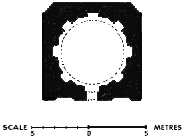
FIG. 117.—WÂNEH, IMÂM MUHAMMAD 'ALÎ.
|
|
which lie upon the banks of the old Tigris bed. In time of flood the river overflows the land as far west as Mdawwî. From here we crossed a plain, all of which much have been inhabited, for it was scattered with mounds and covered with fragments of Mohammadan coloured pottery, blue and green, yellow and purple, and in three-quarters of an hour we reached Tell Bshairah, where there were quantitites of potsherds and bits of burnt brick. The land round it is watered in flood time by canals from the Tigris, and at that time sown with summer crops. The mounds of 'Ukbarâ1
---------------------------
1 'Ukbarâ was a well-known place in the days of the Khalifate. Mukaddasî (ed. de Goeje, p. 122.) It lay on the east bank of the Tigris, i.e. on the east bank of the old channel. Le Strange, Lands of the Eastern Caliphate, p. 50.
---------------------------
lie an hour further to the north. A little to the west of these mounds is a small ruin known as Kahf 'Alî consisting of two chambers of baked brick, one of which had been covered by a dome set on squinch arches. I suppose that it was a shrine or tomb of the late Abbâside period. Thence we rode up the dry
[ Illustrations opposite p.202 ]
FIG. 118.—WÂNEH, IMÂM MUHAMMAD 'ALÎ.
FIG. 119.—KÂDISÎYAH FROM SOUTH-EAST.
[ Illustrations opposite p.203 ]
FIG. 120.—SÂMARRÂ, RUINED MOSQUE FROM SOUTH. (enlargement)
FIG. 121.—SÂMARRÂ, FROM MALWÎYEH. (enlargement)
FIG. 122.—SÂMARRÂ, RUINED MOSQUE, INTERIOR OF SOUTH WALL. (enlargement)
/ WÂNEH p.203 / bed of the old Tigris to the tomb of the Imâm Muhammad 'Alî lying among mounds that mark the site of the village of Wâneh (Fig. 117). The tomb is built of fine burnt bricks measuring 20 x 20 x 6 c., pale in colour, nearing to yellow, like the bricks I had previously seen scattered over the mounds. It is a square-domed building, but the dome rests on an interior octagon and is set at each of the eight angles on a shallow pointed squinch arch (Fig. 118). Pointed arched niches occupy seven of the sides; in the eighth is the door. There is a system of niching on the facade which has been considerably destroyed by the addition of a rude porch of sun-dried brick. The mazâr is a typical example of the small Mohammadan memorial shrine, and from the excellence of its workmanship and the character of the brick I should place it within the Abbâsid age.1
---------------------------
1 Kiepert marks Wâneh to the south of 'Ukbarâ, whereas I should place it a little to the north. We rode to Sumeikhah in about an hour from the Imâm Muhammad 'Alî, which would have been impossible from Kiepert's Wâneh, or for that matter from his 'Ukbarâ. I am relying, however, for the names upon the not too certain testimony of Kâsim. Both 'Ukbarâ and Wâneh are mentioned by Mukaddasî, but he gives no indication of their relative position. He provides us with no more information about Wâneh than its name (ed. de Goeje, pp. 54 and 115), which he spells Aiwanâ. The customary mediaeval spelling is Awânâ, and other authorities place the town on the west bank of the old Tigris bed, while 'Ukbarâ lay opposite to it on the east bank (Streck: Die alte Landschaft Babylonien, p. 227). This would correspond fairly well with my itinerary. I rode from 'Ukbarâ in a north-westerly direction and reached Wâneh in forty-five minutes.
---------------------------
From Wâneh we rode in an hour to Sumeikhah, where we found our tents pitched in a charming palm garden. Sumeikhah is a modern village lying on the Dujeil at a point where a little water still flows down the canal from the Tigris, enough to satisfy the inhabitants and keep their palm gardens in a flourishing condition. Like all Senîyeh villages it has a prosperous appearance. The peasants are well to do, having been exempted under the old régime from the greater part of the ordinary taxes and from military service. With the memory of the previous night of storm freshly in our minds we felt that we had reached an agreeable haven. The temperature had fallen by an average of ten degrees after the rain; the palm garden was a delicious / p.204 / camping-ground, which we shared in all amity with a family of storks who had built their nest on the angle of the enclosing wall. And we knew as little as they of the counter-revolution which had overwhelmed Constantinople that very day.
Next morning I left my caravan to follow the straight road and turned again to the east. In an hour we reached Tell Hir, where there had been a considerable town on the old Tigris; thirty-five minutes further there was a similar mound, Tell Ghazab, and in thirty-five minutes more we came to Tell Manjûr. From Tell Manjûr to Tell edh Dhahab, three-quarters of an hour to the north, a large area, stretching down to the Tigris, is completely covered with mounds and strewn with pottery. The pottery is not coloured or glazed, but ornamented with roughly scratched patterns and narrow raised bands, a Mohammadan ware with which I was to become very familiar at Sâmarrâ. The whole site must therefore have been inhabited in the Mohammadan period, but in all probability it was occupied by a city of earlier fame. On the east bank of the Tigris, above the point where it is joined by the river 'Adem, and therefore exactly opposite the mounds which I saw on the west bank, Ross discovered a great stretch of ruins and believed them to be the ruins of Opis.1
---------------------------
1 Journal of the Geog. Soc., Vol. XI. p. 124.
---------------------------
The Tigris, when it changed its course, must have cut through the area of Opis, so that one half of its mounds now lie to the east of the river and one half to the west. Opis is mentioned by Xenophon2
---------------------------
2 Anabasis, Bk. II. ch. iv. 25.
---------------------------
and by Herodotus.3
---------------------------
3 Bk. I. 189.
---------------------------
It was the most important city of Babylonia after Babylon. Alexander's ships touched there on their voyage up the Tigris, and Strabo observes that the river was navigable up to that point.4
---------------------------
4 Bk. XVI. ch. i. 9.
---------------------------
But in Strabo's time it was no more than a village, and Pliny does not mention it, unless his Apamea is a later name for Opis.5
---------------------------
5 Bk. VI. ch. xxxi. Though I believe that the ruins on the east bank seen by Ross and the extensive ruin field on what is now the west bank of the Tigris must represent Opis, the locating of the city is complicated by the fact that Xenophon took four days to reach Opis from Sitace. Now if Sitace is anywhere near Baghdâd it is strange that the Greeks should have marched four days and got no further than a town situated immediately to the north of the 'Adêm. The Physcus, which Xenophon crossed by a bridge of boats before coming to Opis, may be the 'Adêm, but some have supposed it to be the great Kâtûl-Nahrawân, a loop canal on the east bank of the Tigris. I do not know, however, that there is any record of a canal here before the Sassanian period (Le Strange: Lands of the Eastern Caliphate, p. 57). Chesney tried to solve the difficulty of Xenophon's march by placing Opis higher up the river at Kadsîyeh, but that would leave the great ruin field lower down unidentified, and would, besides, leave too long a time for the march from Opis to the Great Zâb, which occupied the Greeks eleven days. For the site of the Babylonian Opis, see King: Sumer and Akkad, p. 11.
---------------------------
/ BALAD p.205 / The mounds and pottery continued uninterruptedly almost up to the Mazâr of Sayyid Muhammad, which we reached in an hour from Tell edh Dhahab. The mazâr is a mosque with a fine great dome decorated with coloured tiles; and near the mosque is a large khân. I do not know whether there was an older shrine here; the present mosque is dated by an inscription: A.H. 1310, i.e. A.D. 1893. An hour from the mazâr we came to Balad, a large village on the Dujeil. It existed in the thirteenth century for it is mentioned by Yâkût, but it can scarcely have been more flourishing then than it is now, with its walled gardens filled with fruit-trees, its well-laid roads and well-bridged irrigation canals. There was no need to ask who was landlord here, so clearly did the place bear the stamp of the Senîyeh estates, nor is it necessary to point out that if the irrigation system were restored to its old perfection, the country from Baghdâd to Balad might again be as thickly populated as it was in the Abbâsid age.1
---------------------------
1 It is probably one of the districts which were ruined by the Mongol invasion.
---------------------------
We rode down to the Tigris ferry in two and a half hours, and the way was beguiled by the conversation of an Arab of the Mujamma', who happened to be going in our direction. He gave us the news of the desert, telling us of Kurdish raids on the east bank of the river (commonly called the Khawîjeh) and of jealousies between the 'Anazeh and the Shammar on the west bank, the Jezîreh. We breathed a familiar air, even though the Kurds were a new element in / p.206 / desert politics. The Arab did not hold these episodes to be of great account, in spite of the fact that the Kurds had completely blocked the post-road from Baghdâd to Kerkûk; "Ghazû marû!" he said, using an expressive Turkish locution, "raids maids."1
---------------------------
1 i.e. "raids and so forth"; the second word is merely a repetition of the first with the initial letter r changed to m. This convenient form is very common in Turkish.
---------------------------
We found the caravan in the act of crossing at the ferry. I sat down upon the bank to wait for the return of the ferry-boat and fell into talk with the owner of a pair of performing monkeys.
"Where are you going?" I asked, after I had fed the monkeys.
"Ila'l wilâyah," he replied vaguely, "to the capital," and I gathered that he was making his way to Môsul. But he thought better of it when he got to the other side of the river, and for that night he interrupted his journey that he might enjoy our company. He was wise, since he and the monkeys were invited to share our supper, but I fear it was not the man who moved me to hospitality. As we crossed the Tigris the ferrymen composed and sang a piece at my intent. It was of a purely utilitarian character and ran thus—
Jenâh es Serkâr: Hôsh, hôsh!
Fi khidmat: Hôsh, hôsh!
Bakhshish: Hôsh, hôsh!
Her Excellency the Governor: draw together!
In her service: draw together:
A gratuity: draw together! |
There were many more verses, but the gist of all was the same. From our camp by the water's edge we could see the famous spiral minaret of Sâmarrâ, the Malwiyeh, and watch the keleks going down from Diyârbekr to Baghdâd. Now a kelek is a raft made of logs or brushwood laid over inflated skins, and it carried all the merchandise of the Tigris.
We were lying within the dry cutting of a canal dug by Hârûn er Rashîd, and now called the Nahr el Kâim. It is connected with the Tigris by several cross-cuttings, over one / KÂDISÎYAH p.207 / of which we passed a quarter of an hour from the camping-ground, and found upon the further side the ruins of Kâdisîyah.1 (Fig. 119).
---------------------------
1 This Kâdisîyah must not be confounded with the battlefield near Hirah where Khâlid ibn u'l Walîd overthrew the Sassanians.
---------------------------
They are nothing but a crumbling wall of sun-dried brick enclosing an octagonal area, but whether this space was ever covered with buildings it is difficult to determine2;
---------------------------
2 Sarre thinks it was empty, and holds that the town was never finished or inhabited. He would therefore place here Kâtûl, the site first fixed upon for his capital by the Khalîf Mu'tasim when he left Baghdâd. Finding Sâmarrâ to be better placed, he abandoned Kâtûl before the work there was completed: Ya'kûbî, ed. de Goeje, p. 256. Sarre: Reise in Mesop. Zeitsch. der Gesell, für Erdkunde zu Berlin, 1909, No. 7, p. 437. Schwartz, however, suggests that Kâtûl may have lain to the north of Sâmarrâ: Die Abbâsiden-Residenz Sâmarrâ, p. 5. Ross thought that Kâdisîyah was Sassanian, but I am persuaded that he was in error. (A Journey from Baghdâd to Opis, Journal of the Geog. Soc., Vol. XI. p. 127.) Jones gives a plan: Memoirs, p. 8.
---------------------------
I noticed, however, that the surface of the ground was piled into low mounds such as are left by the decay of sun-dried bricks. The octagon is far from regular. I paced the eight sides of the enclosing walls and found them to vary considerably from interior angle to interior angle, the smallest side being 565 paces, the largest 725 paces. Each angle is provided with an exterior round bastion, and at intervals of from twenty-eight to twenty-nine paces smaller round bastions project from the face of the wall. Six of the sides are broken by three gates apiece, one by four gates and one by two. The double-gagted wall is the northern side of the octagon, and in the middle part of its length, between the two gates, there is a series of ten small vaulted chambers (3.55 m. wide by 3.65 m. deep) set against the interior face of the wall. The barrel vault of some of these chambers is still fairly well preserved. It is built of sun-dried brick laid in slices against the head wall on the Mesopotamian system, by which centering was avoided. Round the interior of the octagon, at a distance of thirteen paces from the wall, runs a shallow ditch, ten metres wide, having on its inner side a low mound which occupies a space about seventeen metres wide. The mound is no doubt the remains of a wall. Opposite each of the / p.208 / doorways in the outer wall, a causeway has been laid across the ditch. A wall and ditch upon the inner side of a strong fortification such as the enclosing wall of Kâdsîyah are singular features. They can scarcely have been intended for defence, indeed I am not certain that they extend round the whole enclosure. The ditch may have been a canal bringing water to the palace or fortress.
We rode out of one of the western gates of Kâdisîyah and in a little over an hour reached the enigmatic tower of Kâim. It stands in the angle formed by the Tigris and the channel of the Nahr el Kâim, which has silted up so that no water runs down it from the river. The tower is a truncated cone composed of pebbles and concrete; there is no chamber inside it and no means of climbing to the top of it. It looks as if it had received some sort of facing, and in that case the existing cone is only the core of the tower, but whether it was intended merely to mark the opening of the canal, or whether it is, as Ross supposed, a relic of remoter antiquity, it would be impossible to determine, though I incline to the view that it is ancient. Having crossed the Nahr el Kâim, we found ourselves almost immediately among vestiges of the immense city of Sâmarrâ, of which the bazaars and palaces stretched uninterruptedly along the east bank of the Tigris for a distance of twenty-one miles. This city, which was during the brief time of its magnificence the capital of the Abbâsid empire, sprang into existence at the bidding of the Khalif Mu'tasim and was inhabited by seven of his successors, who added market to market, palace to palace and pl.easure-ground to pleasure-ground. After a period of forty years (836-876 A.D.) the Khalif Mu'tamid removed the seat of his government back to Baghdâd; with his departure the walls of Sâmarrâ crumbled back into the desert from which they had arisen, and like the rose-scented clay of Sa'dî's apologue when the fragrance had vanished, became once more the dust they had been. A glory so dazzling, so abrupt a decline, can scarcely be paralleled on any other page of history. Encompassed by a league-long expanse where the surface of the waste is tumbled into confused masses of mounds or marked / SÂMARRÂ p.209 / off by the vast rectangular enclosures of palace and garden, stands the modern town of Sâmarrâ, no better than a walled village, except that above its mean roofs hang the incomparable domes of the Shî'ah sanctuary, one a-glitter with gold, the other jewelled with precious tiles. And behind the town the huge Malwîyeh,the spiral tower of Mutawakkil's mosque, lifts its head high over the wilderness.1
---------------------------
1 The Malwîyeh can scarcely be any other than the minaret described by Balâdhurî among Mutawakkil's buildings: Futûh ul Buldân, p. 306, Cairo edition of 1901. The ruins of Sâmarrâ have not yet received the detailed study which they deserve, but Professor Sarre and Dr. Herzfeld are about to begin an exhaustive examination of the site. Sketch plans have been published by De Beylié (Prome et Samarra), and at about the same time Herzfeld brought out a small monograph entitled Sâmarrâ. I had this monograph with me, and finding the plans to be incorrect and the drawings inexact (for example, the ornament drawn in fig. 5 gives little idea of the original), I measured and photographed all the ruins over again. Meantime Viollet has published a short account of his journey in Mesopotamia, in which he has given plans of the ruins of Sâmarrâ : Le Palais de Al Moutasim, etc. Mémoires of the Acad. des Inscrip. et Belles-Lettres, Vol. XII. Part II. His attempt to reconstruct the ground plan of the palace of which the Beit el Khalifah forms part, is of great interest.
---------------------------
Mu'tasim's choice of Sâmarrâ as the site of his new capital when Baghdâd had become distatsteful to him was, according to the Arab historians, determined by the purest hazard. Ya'kûbî, writing at the close of the ninth century when Sâmarrâ had recently been abandoned, relates that Mu'tasim fixed first upon Kâtûl, a point lower down the river, but that the site did not prove satisfactory.2
---------------------------
2 Ed. de Goeje, p. 256.
---------------------------
And upon a certain day he rode out to the chase; "and he continued upon his way until he came to a place called Surra man raa" (who sees it rejoices), "which is a desert of the Tîrhân district; there were no buildings in it, and no inhabitants, except a Christian monastery. And he stopped at the monastery and spoke with those who were in it, and said: 'What is the name of this place?' And one of the monks said: 'We find in our ancient books that this place is called Surra man raa, and that it was a city of Shem son of Noah.' " Mu'tasim accepted the good omen, together with other prophetic matter
/ p.210 / related by the monks, and chose the place for his capital. The etymology was, however, as fortuitous as was the khalif's selection; the name Sâmarrâ has in reality nothing to do with the Arabic phrase. A town had existed on the Tigris bank long before Arabic was spoken there; it was called in Aramaean Sâmarrâ, and Ammianus Marcellinus alludes to it as Sumere.1
---------------------------
1 Lands of the Eastern Califate, p. 53. Am. Mar., Bk. XXV. ch. vi. 4.
---------------------------
Half-way between Kâim and the modern Sâmarrâ we came to the first of the palace enclosures, a large oblong space surrounded by a ruined wall of sun-dried bricks set with round bastions. The remains of a gateway decorated with niches led into another enclosure similar to the first, and both stretched down to the river-bank. From this point the surface of the ground is seamed with ruin mounds, and just before we reached Sâmarrâ (about an hour from Kâim) we passed another clearly-marked enclosure by the river. My camp had gone on while I was examining Kadsîyeh, and Fattûh had pitched the tents on the brink of the high bank that overhangs the Tigris. When I saw it I rejoiced, like Mu'tasim, for the position could not have been bettered; and moreover the modern town of Sâmarrâ stands somewhat back from the river, so that we did not molest its Shî'ah inhabitants, neither did they disturb us.
There is only one way of appreciating the extent of the Abbâsid city, and that way lies up the spiral path of the Malwîyeh tower (Fig. 121). It is seldom that the desert offers so wide an expanse to the eye, since nowhere else is the gazer mounted upon a lofty steeple in its very midst. Below the minaret lies the enclosure of the great mosque, a massive brick wall with round bastions; but the colonnades that protected the worshippers from sun and rain have all vanished and are indicated only by even trenches, marking the place from which the columns or piers have been removed. In the central court, surrounded by the colonnades, lies the shadowy outline of a fountain, and beyond the walls a long low mound shows that the precincts must have been bounded by an outer enclosure.2
---------------------------
2 This is marked in Viollet's plan.
---------------------------
/ SÂMARRÂ p.211 / South of the mosque, in open hummocky ground, the little town of Sâmarrâ with its glittering domes is set down like a child's toy upon the waste — a toy half broken and thrown away. All round it the uneasy desert has rolled in over the city of the khalifs, covering but not obliterating the streets and courts, of which the walls are dimly apparent, as though they struggled through a veil of silted sand. To the north are the shattered walls and bastions of a great rectangular enclosure, Madakk et Tabl the Arabs call it (the Place of the Beating of Drums), and about it the parallel streets of the city are drawn upon the surface of the earth, ruled out by the pencil of a giant artist. Still further north the three halls of the palace of the khalifs stand amid an immense area of shapeless mounds, and far away a second spiral tower, the minaret of Abu Dulâf, lifts its head out of the plain. The waters of the Tigris bring no colour to the vast landscape; the dead and silent world is like a battlefield, wherein men fought out the secular contest with the wilderness, and lost, and left it empty of all but ruins.
I came down from the tower and set to work upon the mosque.
To measure a wall would not seem to be a complicated business, yet I do not care to remember how many hours I spent upon the mosque. Its great size is no advantage when seen over the edge of a metre tape, and the action of the wind upon its masonry has been fatal to accuracy. The face of the brick is destroyed higher than a man can reach by the constant scrub and wear of the heavier sorts of desert dust, which makes the exact noting of angles exceedingly difficult. The buildings on the west bank of the river, among which I spent the two succeeding days, were even more disfigured, and the palace of the khalifs, except for its three vaulted halls, a crowning confusion of mounds and rock-cut subterranean chambers. It was not until I had made acquaintance with all these that I found time to visit the modern town. I had been spending a few final hours in the great mosque and was beginning to wonder whether a metre tape and a camera are advantageous additions to the equipment of travel, a doubt which / p.212 / was shared by the zaptieh and Jûsef, whose duty it was to stretch the one and carry the other over weary acres of crumbling ruin. When at last we turned our horses' heads to the little town lying out upon the plain, we felt that there was a great deal to be said for prejudices which forbid the measuring and photographing of mosques that cover the bones of saints. The town walls have recently been rebuilt, for the acquisition of merit, by a pious Persian; he neglected, however, to turn his attention to that which they enclose, and the first few hundred yards of sacred Sâmarrâ is a vacant desolation, the home of dust and dirt. Having crossed this area we plunged into mean and narrow streets. All the windows facing outwards had been blocked up, and within or without there was no living soul to be seen as we rode down the silent ways. But when we drew near the mosque we became aware that Sâmarrâ was not quite uninhabited. Grave Persians and ragged Arabs sat at the tea-shops before the gateway; they gave me the salute as I passed, and I was careful not to gaze too curiously through the arch where the big chain hangs across the entrance of the shrine. Inside, under a dome of priceless tiles, are the tombs of the tenth and eleventh Shî'ah Imâms, while the smaller dome of gold covers the cleft into which vanished the Mahdî, who will appear again when the time is ripe. Therefore when you see black ensigns, black ensigns coming out of the east, then go forth and join them; for the Imâm of God will be with those standards, and he will fill the world with equity and justice.
We left Sâmarrâ early in the morning and rode through almost continuous ruin-heaps to Shnâs, which we reached in an hour and forty minutes. It is nothing but a great enclosure, the walls and towers built of sun-dried brick, and consequently much ruined. The towers are placed astride the wall instead of upon one side of it only.1
---------------------------
1 Herzfeld, Samarra, p. 61, places the old quarter of Karkh at Shnâs and Dûr Árabâyâ at Eskî Baghdâd. Karkh is the Charcha of Ammianus Marcellinus.
---------------------------
A few minutes further north lies an oblong enclosure nearly a third of a mile across, with a walled triangle to the north of it, in
[ Illustrations opposite p.212 ]
FIG. 123.—ABU DULÂF, FROM EAST. (enlargement)
FIG. 124.—ABU DULÂF, INTERIOR, LOOKING NORTH. (enlargement)
[ Illustrations opposite p.213 ]
FIG. 125.—NAHRAWÂ:N CANAL.
FIG. 126.—IMÂM DÛR.
/ DÛR p.213 / which is a small square enclosure near the river, with foundations of burnt brick. Still further north are some ruin-heaps which are said to represent the tomb of a holy man. This group of ruins is known as Eskî Baghdâd, but the name is applied loosely to the whole area round Abu Dulâf. We crossed a dry watercourse and rode on over mounds for another hour and a half, when we came to the mosque of Abu Dulâf (Fig. 123). Now Abu Dulâf is brother and complement to the mosque at Sâmarrâ, for whereas at Sâmarrâ the arcades have fallen and the outer wall stands, at Abu Dulâf the arcades stand and the outer wall is ruined. I looked in vain for traces of a water-basin in the centre of the court, but being no true antiquarian, I was well consoled for its absence by finding a tall borage plant where the fountain should have been. It lifted its blue flowers gaily out of the dust, and every time I crossed the court I made a circuit that I might look into its clear eye. It was the first flower that we had seen upon the face of the desert for many weeks, and it heralded the end of the region wherein the drought had wrought such havoc. Late in the afternoon I got down to my camp by the Tigris. Fattûh had sought a lodging for the night inside the enclosing walls of a palace, and whatever prince it was who housed us, he gave us a lavish hospitality as regards sunset and rising stars and gleaming curves of river.
Half-an-hour's ride brought us on the following morning to the northern limit of Sâmarrâ. In the angle between the Tigris and the Nahrawân canal lie the remains of Mutawakkil's tragic palace, built in a year, inhabited for nine months, destroyed and deserted, together with all the quarter round it, when Muhammad el Muntasir caused the khalif his father to be murdered within its walls. Immediately beyond it we crossed the dry channel of the Nahrawân, which was cut by the Sassanian kings in order to bring water to the fertile regions below Sâmarrâ (Fig. 125). At the point where our path crossed it are the brick foundations of a bridge, below a large artificial mound.1
---------------------------
1 Mutawakkil began a new canal from the Tigris to the Nahrawân, / p.214 / the latter having silted up by the ninth century, but the labour of cutting through the hard conglomerate was found to be too great and the work was abandoned. I do not know whether the canal I crossed was of his making, but I fancy it was the Nahrawân itself, perhaps cleared and deepened by him. Ross (op. cit., p. 129) speaks of bridge foundations formed of large "artificial stones" (concrete?) "joined together by iron clamps and melted lead." I saw nothing but brick, but Ross's bridge may well be, as he conjectured, earlier than the Mohammadan period, since it probably spanned the Sassanian canal. I thought the artificial mound to be pre-Mohammadan.
---------------------------
/ p.213 /
The dry bed of the canal, hewn for / p.214 / scores of miles, straight as a Roman road, through the solid rock, is as impressive as the most magnificent of ruins; for the king who could bid rivers to flow and crops to spring in the barren wilderness was indeed lord of the earth.
As we reached the village of Dûr, an hour further to the north, we met a number of the inhabitants coming out along the road, and all were armed with rifles. We stopped and asked them whither they were bound, and they in turn inquired of us whether we had seen anything of a caravan of merchandise from Sâmarrâ. It was due to arrive at Dûr that morning and they felt some anxiety as to its safety, since the desert was much disturbed. There are no soldiers posted on the left bank of the Tigris, and every man must protect his own property. But we, having come only from Abu Dulâf, could not reassure them. On the outskirts of Dûr the plain is once more tossed into ruin-mounds, probably of the Mohammadan period. The village stands upon an old site; Dûr is mentioned by Ammianus Marcellinus in his account of Jovian's retreat. It is remarkable only for the shrine of the Imâm Dûr (Fig. 126), Muhammad ibn Mûsa ibn Ja'far ibn 'Ali ibn Hussein — his genealogy goes back to a respectable Shî'ah ancestry, and I read it on an inscription cut upon a marble slab by the door. Moreover, while we waited for the mullah to appear with the key, one of the villagers busied himself with scraping away the whitewash which covered the lower part of the inscription, and we deciphered the date, 871 of the Hijrah, which is 1466 A.D.1
---------------------------
1 There is some doubt about this inscription. Professor Sarre copied it without noticing the date, which was covered with whitewash; he gave it to Professor van Berchem, who decided that the shape of the / p.215 / letters pointed indubitably to the ninth century. Professor van Berchem's authority in such matters is not to be questioned, but the date must be accounted for. Perhaps it was a later addition, put in when the shrine was repaired.
---------------------------
/ p.214 / While we were thus engaged the / DÛR p.215 / mullah joined us, a rubicund old man in a spotless turban. The reluctance which he displayed on being invited to unlock the door was terminated by the zaptieh, who took him aside and explained that I was employed by the government as a surveyor; upon which the mullah, with perhaps a silent reflection on the laxity of the age in the matter of official appointments, threw open the door and bade me enter (Fig. 127). The shrine is a high square tower of fine brickwork, laid at the top so as to form patterns, and, on the north side, inscriptions. Above this tower rises a conical roof constructed, like the roof of the Sitt Zobeideh at Baghdâd, by means of a series of alveo-
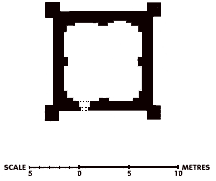
FIG. 127.—IMÂM DÛR
|
|
late niches or squinches. In the interior this pointed dome is covered with plasterwork of a character totally different from the stucco decorations of Rakkah and Sâmarrâ, to which it stands in the same relation as baroque to cinque cento work. It cannot belong to the same period as the brick walls of the chamber, for it blocks the windows, and my impression is that the whole roof is considerably later than the lower part of the shrine. The mullah, in full assurance of my distinguished position, and sustained by lively hopes of a sufficient reward, looked on with benignant interest while Jûsef and I measured the shrine; but his hopes were to prove as ill-founded as his assurance, for when I opened my purse, prior to departure, it contained nothing but three piastres. I had emptied it the night before on behalf of an obliging person who had accompanied us to Abu Dulâf, and had forgotten to replenish it. To crown all, the money-bags were / p.216 / with the caravan, and the caravan was a full two hours ahead on the road to Tekrît. I do not know who was the more disconcerted by this unlucky accident, but the mullah bore it with the greater dignity. After I had confounded myself in explanation and apology, he nodded his head, folded his hands into his sleeves and dismissed me smilingly.
"Nasîb !" he said, ''a misfortune. Go in peace."
The subsequent events of the day must have been intended as a judgment upon me. By the time we came down to the river bank opposite Tekrît, three hours from Imâm Dûr, a strong wind had arisen, and we found the caravan standing dejectedly at the water's edge while Fattûh called upon God to hasten the movements of the ferrymen. His prayers were far from efficacious (moreover, he had forgotten to put up a supplication for a water-tight boat), and the crossing was longer and more tiresome than any we had experienced (Fig. 128). It was near sunset before we got into camp on the high ground behind Tekrît, and the last of the muleteers did not come in with the riding horses until after dark.
No sooner were the tents pitched than a messenger waited upon me to ask whether I would receive Hmeidî Beg ibn Farhân. I returned an answer couched in respectfully cordial terms, since no one who has travelled in the desert is ignorant of the name of Farhân, who was the Sheikh of Sheikhs of all the northern Shammar. Since the death of Ibrahîm Pasha, the Shammar and the 'Anazeh share, without amity, the lordship of Mesopotamia, as they did before the Kurd rose into power. The road from Tekrît to Môsul is in Shammar territory, so far as it can be said to be in the territory of any one. Not a caravan passes up and down but it pays tribute to Mejwal ibn Farhân, a beshlik (three piastres) on every mule, and half a beshlik for a donkey, unless the travellers happen to be escorted by a zaptieh as I was. Muleteers cannot afford zaptiehs, and when they see two spearmen of the tribe upon the road, they pay and lodge no complaint in deaf ears. Sheikh Mejwal, who is the strongest of Farhân's fourteen sons, levies a tax from all the Jebbûr, the tribe that camps along the river, and I was told that whereas the Jebbûr
[ Illustrations opposite p.216 ]
FIG. 128.—TEKRÎT FERRY.
FIG. 129.—COFFEE-MAKING, SHEIKH 'ASKAR.
[ Illustrations opposite p.217 ]
FIG. 130.—TEKRÎT, THE ARBAÎN.
FIG. 131.—KHÂN KHERNÎNA, MIHRÂB.
/ TEKRÎT p.217 / had once been breeders of horses, now they breed none, finding it an unprofitable labour with the Shammar sheikhs alert to seize every likely mare. Hmeidî is said to be the mildest of Farhân's brood. He is a handsome man of middle age, with deepset eyes and a gentle, rather indolent expression. He had come to Tekrît on some business connected with sheep stealing, and hearing of my arrival he hastened to bid me welcome to these deserts and to make me free of the Shammar tents. I asked him news of his cousins in Nejd, where the Shammar princes of the Benî Rashîd hold with much bloodshed a hazardous authority, and when he had spoken of these matters he gave me a piece of news which he thought, and rightly, might be of no less interest. It was rumoured that the Sultan had dismissed the deputies, but how or why no one knew, though the counter-revolution was now more than a week old.
Tekrît is the birthplace of Saladin. It is seen to the best advantage from the other side of the Tigris, where the bold bluffs and steeply falling banks to which its houses cling are imposing to the eye. The distant promise is not fulfilled; the modern town is devoid of interest and little remains of the mediaeval town but ruin-heaps, the line of a wall and part of the lower gateway of the citadel. Tekrît was the seat of a bishopric; Ibn Haukal, writing in the tenth century, states that most of the inhabitants were Christians, and Rich speaks of the remains of ten churches.1
---------------------------
1 A Residence in Koordistan, Vol. II. p. 147. The book was published in 1836.
---------------------------
Beyond the ruins of the old town, which extend far to the west of modern Tekrît, there lies the Moslem shrine of the Arba'în, the Forty, much dilapidated, though two small chambers covered with domes are still intact. These chambers, and the ruined precincts adjoining them, are decorated with stucco of the same character, and I should say of the same date, as the ornaments of Imâm Dûr (Fig. 130).
We set out from Tekrît with a large and unusually nondescript company, or perhaps it would be truer to say that they / p.218 / set out with us, a European and a couple of zaptiehs being valuable assets on the Môsul road. Half-a-dozen Kurds from above Mardîn and as many Nestorians from the mountains south of Lake Vân marched with my pack-animals, and presently we fell in with the Father of Monkeys, as Fattûh called him, who had not made much haste on his way to the capital. There was also a young sayyid, white-turbaned and somewhat forbidding of aspect; with him too I made friends after I had conquered the distaste born of his over-godly looks. "I love thieves and pigs," murmured one of the muleteers, "Yezîd and Druze, but I do not love sayyids or mullahs." This particular descendant of the Prophet addressed me systematically as Queen, and I experienced a not unnatural gratification at being raised to royal rank, though whether it is higher than that of consul I cannot be sure. With the Nestorians I was immediately on terms of intimacy. They were sturdy, bearded mountaineers of a type which it is impossible not to appreciate, even at first sight, and they marched cheerfully through dust and heat with no possessions but a water-flask and a crust of bread. Their pointed felt caps and close-fitting cotton trousers formed a costume which was new to me, and as they walked beside my mare I asked them who they were and whence they came.
"We are the people of Mâr Shim'ûn," said one, naming the hereditary patriarch of their faith. "Effendim, we have no friends but the English — Islâm, Armenians, all are our foes."
A struggling sect is the ancient community of Mâr Shim'ûn, harassed by the Kurds in their mountain fastnesses, but if they may be judged by their brave and independent looks, they do not turn the other cheek to the striker.
We rode for three hours through monotonous country, a barren and stony wilderness raised high above the river. When we dropped down to the water's edge we found the land to be partly cultivated by the men of Tekrît, but the Tigris is eating away the right bank and in places field and
[ Illustrations opposite p.218 ]
FIG. 132.—KHÂN KHERNÎNA, DETAIL OF FLAT VAULT.
FIG. 133.—KHÂN KHERNÎNA, VAULT, SHOWING TUBE.
[ Illustrations opposite p.219 ]
FIG. 134.—KHÂN KHERNÎNA, SETTING OF DOME.
FIG. 135.—TELL NIMRÛD.
/ KHÂN KHERNINA p.219 / path have been destroyed by the depredations of the stream.1
---------------------------
1 Kalát Abu Rayâsh, which is marked in Kiepert's map, has almost disappeared, the high ground on which it stands having fallen away and carried the walls and towers with it.
---------------------------
We camped that night six and a half hours from Tekrît, near a kishlâ which has recently been built at the expense of a very beautiful khân. The kishlâ represents a spasmodic attempt on the part of the government to control the tribes; it holds from forty to fifty foot soldiers, who, since they are unmounted, cannot pursue or punish the marauding Arabs. The walls of Khân Khernîna, a magnificent Mohammadan building of the finest period, have therefore been laid low to no purpose, and the soldiers lead a miserable and useless existence in the kishlâ, which has been erected out of its bricks. The khân is now so much ruined that I did not attempt to plan it. It is a rectangular enclosure with round bastions in the walls, and fine gateways covered with pointed arches. Along the south side stretches a vaulted corridor, interrupted towards the middle of its length by a chamber which has served as a mosque. This chamber contains a mihrâb decorated with exquisite arabesques in stucco; of the inscription which was placed beneath the pointed arch only a few letters remain (Fig. 131). The barrel vaults of the corridor, corbelled slightly forward from the wall and built without centering, are splendid examples of Mesopotamian brick construction. The roof of a small chamber at the south-east angle, and the four-sided dome of the mosque, show the singular arrangement which I had noticed at Baghdâd of a flat piece of masonry laid over the summit of the vault (Fig. 132). A square chamber near the mosque had been covered with a dome, and in one corner a squinch arch, decorated with a tiny ornamental arcade, is still standing (Fig. 134). On the flanks of the barrel vaults I observed the same system of tubes which exists at Ukheidir (Fig. 133). The masonry and the plan of the building are closely akin to thirteenth-century work in Baghdâd, and to that period I should assign it.2
---------------------------
2 Khân Khernîna is not mentioned by Ibn Jubeîr nor by Ibn / p.220 / Batûtah, who both travelled by this side of the Tigris from Tekrît to Môsul, the one at the end of the twelfth century, and the other in the middle of the fourteenth century.
---------------------------
There is another guard-house thirty minutes further up the Tigris, Sheramîyeh is its name. Here we stopped on the following morning to water our horses, for our road now led us far from the river. A low line of rocky hills, the Jebel Hamrîn, borders the west bank for several hours' journey. It runs crosswise over the desert and the river cuts through it by the Fethah gorge. The hills drop sheer into the stream, leaving no space for a path, and caravans are obliged to skirt the western slopes, where there is little water and no settled population, though we saw a few encampments of the Deleim far out in the desert. The cups and hollows of the plain were filled with a scanty growth of grass. We rejoiced over the unwonted sight as if each blade were a separate benediction, and Fattûh began to calculate the sums we might save on provender when the horses could be pastured every evening on fresh herbage.
"God is great," said the zaptieh, "but it has been a year of ruin for poor men. We have not known where to look for food for our hoses, and more than that, I have received no pay for six months."
"Please God the new government will give you your pay," said I.
"Please God," he answered. "But when it comes the dâbits" (officers) "eat it. Effendim, once I travelled with a dâbit who received £T18 a month, wallah ! And my pay was 100 piastres a month. Yet whenever he drank coffee he left me to defray the expense. Where is eighteen pounds and where a hundred piastres!"
"God exists," said the sayyid. "Oh Queen, He exists."
"Wallah, He exists," said the zaptieh hopefully.
We camped that night six hours from Sheramîyeh in a sheltered place among the hills beside a spring of which the waters were bitter with sulphur and not unmised with pitch; our companions drank of it, but my servants and I quaffed / KAL'AT SHERGÂT p.221 / royally from the flasks which Jûsef had filled at the Tigris. While the tents were being pitched I walked to the top of the hills, and on the banks of watercourses that had but recently run dry I found flowers, blue larkspurs and purple gentians and a wide selection of the thistle family. A bowl of larkspurs was set upon my dinner-table, and Jûsef was very loath to throw them away when we struck camp, so rare and delicate a possession did they seem to us. But I assured him that the German professors at Kal'at Shergât would have flowers fairer than these. A more wonderful sight was in store for us on the next day's march. We had travelled barely two hours when we splashed into a pool of rain-water, and then into another; there was grass round them, green, abundant grass: "More than we have seen all the way from Aleppo !" exclaimed Jûsef. The region of the drought was over, and when our path led us to the top of the Jebel Hamrîn, here sunk to a low hog's back, I was scarcely surprised to see the slopes down to the Tigris red with poppies. But even the poppies could not withhold the eye from the great mound of Kal'at Shergât by the river's edge, the mound of Asshur, crowned with the crumbling mass of a huge zigurrat, the temple pyramid of the tutelary god of the Assyrians. With the general aspect of the first capital of Assyria I was already familiar, thanks to the excellent photographs published by the German Orient-Gesellschaft, but I was not prepared for so magnificent a prospect. The Tigris in high flood washed the foot of the temple mound; far away to the north ran the snow-clad barrier of mountains whence its waters flow — a barrier which Nature planted in vain against the valour of the Assyrian armies; and across the river the fertile plain stretched away in long undulations to where Arbela lies behind low hills. Bountiful gods had showered their gifts upon the land.
We rode down into the ruin-field and found one of Dr. Andrae's colleagues at work in the trial trenches. He directed us to the house set round with flowers, as I had predicted, wherein the excavators are lodged. There Dr. Andrae and Mr. Jordan made me so warmly welcome that I felt like one / p.222 / returning after absence into a circle of life-long friends. They had grave news to give me, news which was all the more disquieting because it was as yet nothing but a rumour. Constitutional government had foundered suddenly, and it might be for ever. The members of the Committee had fled from Constantinople, the Liberals were fugitive upon their heels, and once more 'Abdu'l Hamîd had set his foot upon the neck of Turkey. So we interpreted the report that had reached Asshur, but since there was no means of allaying or of confirming our anxieties we turned our minds to more profitable fields, and went out to see the ruins.
A site better favoured than Kal'at Shergât for excavations such as those undertaken by Dr. Andrae and his colleagues could scarcely have been selected. It has not given them the storied slabs and huge stone guardians of the gates of kings with which Layard enriched the British Museum; they have disappeared during the many periods of reconstruction which the town has witnessed; but those very reconstructions add to the historic interest of the excavations. Asshur was in existence in the oldest Assyrian period, and down to the latest days of the empire it was an honoured shrine of the gods; there are traces of Persian occupation; in Parthian times the city was re-built, walls and gates were set up anew, and the whole area within the ancient fortifications was re-inhabited. Valuable as are the contributions which Dr. Andrae has been able to make to the history of Assyria, the fact that he is bringing into the region of critical study a culture so shadowy as that of the Parthians has remained to us, in spite of its four hundred years of domination, adds greatly to the magnitude of his achievement. His researches in this direction have been pursued not only at Asshur, but at the Parthian city of Hatra, a long day's journey to the west of the Tigris, where the famous palace is at last receiving the attention it merits.
The temple of the god Asshur, of which the ziggurat is the most notable feature of Kal'at Shergât, goes back to the earliest Assyrian times, but the greater part of it is occupied by a Turkish guard-house, and has not yet been excavated (Fig. 136).
[ Illustrations opposite p.222 ]
FIG. 136.—KAL'ÂT SHERGÂT, THE ZIGURRAT AND RUINS OF NORTH WALL. (enlargement)
[ Illustrations opposite p.223 ]
FIG. 138.—SÂMARRÂ, INTERIOR OF SOUTH GATE, RUINED MOSQUE.
FIG. 140.—SÂMARRÂ, RUINED MOSQUE, SMALL DOOR IN WEST WALL.
/ KAL'AT SHERGÂT p.223 / The court between temple and zigurrat lies open; in a later age the Parthians adorned it with a splendid colonnade, and it is here that Dr. Andrae has succeeded in piecing together large fragments of Parthian architectural decoration which throw a new light both upon the arts of Parthia and upon the succeeding era of the Sassanians. Fortunately there exist upon the mound other temples of the Assyrian period which he has been better able to study. Chief of these is the double shrine of the gods Anu and Adad, lords of heaven and of the thunderstorm, the excavation of which cost him many months of difficult work. The temple was finished by Tiglathpileser at the end of the twelfth century before Christ, but in the course of some three hundred years it fell into complete decay; Shalmaneser II, he who received the homage of Jehu, as is recorded on the Black Obelisk in the British Museum, filled in the ruins of the earlier shrine and set a new edifice upon them, preserving almost exactly the plan of the old. No Assyrian temple has hitherto been studied accurately, save one of Sargon's at Khorsabâd, later by more than a century than the second temple of Anu and Adad; it was therefore necessary to get an exact record of both the periods at Asshur, and in order to leave Shalmaneser's work undisturbed, Dr. Andrae was compelled to trace that of Tiglathpileser by means of a system of underground tunnels. "I have never," he observed, as he surveyed his handiwork, "done anything so mad." But the results have more than justified the labour. The scheme of the Assyrian temple has now been established by examples ranging over a period of four hundred years, and it is conclusively proved that it differed in a remarkable degree from the Babylonian temple plan, and was related to the plan adopted by Solomon. In Babylonia the chambers are all laid broadways in respect of the entrance; that is to say, the door is placed in the centre of one of the long sides, so that he who enters has only a narrow area in front of him, and must look to right and left if he would appreciate the size of the hall. At Jerusalem and in Assyria the main sanctuary ran lengthways, an immense artistic advance, inasmuch as the broadways-lying hall was at best a clumsy contrivance which could / p.224 / never have given the sense of space and dignity conveyed by the other. To the genius of what builders are we to attribute this masterly comprehension of spatial effect? The question cannot as yet be answered, but Dr. Andrae is inclined to seek outside Syria and Mesopotamia for the prototypes of Asshur and Jerusalem. In the palaces, be it noted, the lengthways hall was never adopted, but palace architecture is not well illustrated at Asshur, those buildings having been the first to suffer at the hands of the spoiler.
The walls to the north of the temples are perhaps the most impressive part of the excavations. The mound on which the city is built reaches here its greatest elevation, and the gigantic masses of the fortifications rear themselves up from its very base. Time after time the kings of Assyria renewed these bulwarks, setting them forward further and further against the river, which once washed their foundations — its bed runs now a little more to the east, where the stream still flows under the eastern quays of Asshur. The upper parts of the walls are of unburnt brick, but the lower, as Xenophon observed at Nimrûd, are cased in massive stone. The stonework was not in reality as durable as the brick, for the Assyrians had no binding mortar, and the stones, being set together with mud, could not resist a pressure from behind, such as that which was offered by the mound itself. A mortar of asphalt is sometimes used in sun-dried brick, but binding mortar seems to have been a discovery of the age of Nebuchadnezzar, since it is first found in constructions of his time at Babylon. The fortifications sweep round southwards to the Gurgurri Gate, well known in inscriptions, and identified by epigraphic evidence. Between the gate and the temple and palace area, a great part of the ground is covered with a network of streets and houses belonging to a late Assyrian period. The larger houses consist of an outer court with rooms for servants and dependents, roughly floored with big cobblestones and traversed by a pathway of smaller cobbles whereon the masters could cross to the inner paved court round which their chambers lay. Every house, however small, is provided with a bath-room. The whole complex has / KAL'AT SHERGÂT p.225 / the appearance of another Pompeii, though it is more ancient than the Italian Pompeii by six or seven hundred years. Down in the plain, outside the city walls, stood a magnificent building which has been christened by the excavators the Festhaus. It is a fine open court, surrounded on two sides by a colonnade, while on the side opposite to the gate there is a raised platform of solid masonry. The court must have had the aspect of a formal garden, for at regular intervals there are holes in the hard conglomerate of the floor which the excavators conjecture to have been filled with earth and planted with shrubs. In this colonnaded garden was celebrated the spring sacrifice, the annual festival in honour of the fruitful earth. The plan of the building is not Assyrian — the column itself is a non-Mesopotamian feature — but whence it was derived it would be impossible as yet to say.
Throughout the area of the city a series of deep trial trenches have been dug, cutting through the Parthian period, through the late Assyrian, and down to the earliest times. These trenches afford materials for the most fascinating studies. One of the earliest cities that stood upon the mound of Asshur is, curiously enough, the easiest to trace. The houses are in an unusually perfect state; their walls, preserved not infrequently to a height of several feet, enclose little cobbled courtyards with narrow cobbled streets between. These worn and ancient ways, emerging from under the steep sides of the trench and disappearing again into the earth at its furthest limit, give the observer a sense as of visualized history, as though the millenniums had dropped away that separate him from the busy life of the antique world. It is probable that the city to which they belong was destroyed by some overwhelming catastrophe, laid desolate, perhaps by an onslaught of the Mitanni kings of northern Mesopotamia or of the Babylonians from the south, and so left in age-long ruin until a later generation completed the filling up of court and street which had been begun by time, levelled the whole and built their dwellings upon foundations of the past. The Assyrians were content to leave their story inscribed on clay cylinder or on stone; they did not, like the Egyptians, rear for / p.226 / their dead enduring monuments, but each man in turn was thrust into a clay sarcophagus or sepulchral jar lying immediately below the floor of his own dwelling — we counted as many as fifteen burials in one of the smaller houses — or placed, with a slightly greater regard for the comfort of the living, in an adjoining subterranean chamber vaulted with brick.
As Dr. Andrae led me about the city, drawing forth its long story with infinite skill from wall and trench and cuneiform inscription, the lavish cruel past rushed in upon us. The myriad soldiers of the Great King, transported from the reliefs in the British Museum, marched through the gates of Asshur; the captives, roped and bound, crowded the streets; defeated princes bowed themselves before the victor and subject races piled up their tribute in his courts. We saw the monarch go out to the chase, and heard the roaring of the lion, half paralyzed by the dart in its spine, which animates the stone with its wild anguish. Human victims cried out under nameless tortures; the tide of battle raged against the walls, and, red with carnage, rose into the palaces. Splendour and misery, triumph and despair, lifted their head out of the dust.
One hot night I sat with my hosts upon the roof of their home. The Tigris, in unprecedented flood, swirled against the mound, a waste of angry waters. Above us rose the zigurrat of the god Asshur. It had witnessed for four thousand years the melting of the Kurdish snows, flood-time and the harvest that follows; gigantic, ugly, intolerably mysterious, it dominated us, children of an hour.
"What did they watch from its summit?" I asked, stung into a sharp consciousness of the unknown by a scene almost as old as recorded life.
"They watched the moon," said Dr. Andrae, "as we do. Who knows ? they watched for the god."
I have left few places so unwillingly as I left Kal'at Shergât.
We rode northwards for eight hours and camped at Tell Gayârah, near to which there are some small pitch springs. / TELL NIMRÛD p.227 / The land of Assyria grew ever more fertile as we journeyed up into it, and that night the horses were picketed knee-deep in grass, to the boundless satisfaction of the muleteers. I was anxious on the following day to visit Nimrûd, the Assyrian city mentioned in Genesis as Calah, but in order to do so it was necessary to find a ferry across the Tigris, which was a doubtful undertaking. Even if it were found, the flood might make ferry-boats unprofitable vessels, therefore I detached Fattûh from the caravan and bade him ride with the zaptieh and me, Fattûh being master of a thousand wiles with which to baffle difficulty, and possessor foreby of a remarkably strong right arm. We rode in two hours to Mangûb, where there are few ruined huts. On the opposite bank of the Tigris a number of mounds mark the site of ancient villages. The grass grew thick by the river, and on the higher ground it had also sprouted abundantly, though it was now withered. Presently we spied upon the path in front of us an effendi on horseback, who carried a big umbrella to protect himself from the sun. His state was further enhanced by the presence of a few zaptiehs.
"He is coming to Gayârah," said my soldier. "They have sent him from Môsul to judge a dispute about the crops. Four men were murdered last week at Gayârah, and ten are laying fatally wounded."
This was news to me. I had been peacefully unconscious of the dead and dying as I watched my horses knee-deep in the grass. The effendi, when he came up to us, addressed me as follows:
"Bonjour, Madame. Comment aimez vous le désert?"
"Mais beaucoup," I said, somewhat astonished to hear the French tongue spoken in it. And then I added quickly: "What tidings have you from Constantinople?"
The effendi drew his brows together.
"We hear that troops from Salonica have entered the town and captured two barracks."
"Did they take them without difficulty?" I asked.
"We do not know,' he returned.
"Please God !" said I.
/ p.228 /
"Adieu," he replied hurriedly, and rode upon his way. In those days of uncertainty it was not wise to be drawn into a definite expression of opinion.
Our road took us up a ridge, and when we came to its crest I drew bridle, for the history of Asia was spread out before my eyes. Below us the Great Zâb flowed into the Tigris; here Tissaphernes murdered the Greek generals, here Xenophon took over the command, and having crossed the Zâb at a higher point, turned and drove back the archers of Mithridates. To the north the mound of Nimrûd, where the Greeks saw the ruins of Calah, stood out among the cornfields; eastward lay the plain of Arbela, where Alexander overthrew Darius. The whole world shone like a jewel, green corn, blue waters, and the gleaming snows that bound Mesopotamia to the north; but to my ears the smiling landscape cried out a warning: the people of the West can conquer but they can never hold Asia, no, not when they go out under the banners of Alexander himself.
We rode up the bank of the Tigris, and when we came opposit to Tell Nimrûd there, by good fortune, was a ferry-boat, plying across the river with the men and flocks of the Jebbûr. The cause of their migration to the left bank was hopping about our feet — locusts, newly issued from the rocky ground and swarming over every blade of grass and corn.
"In two days there will be no pasture, and our flocks will die," explained an aged shepherd. "Let the consul cross !" he shouted, as the ferry-boat drew up beside the bank and half the tribe clambered into it.
We ejected two calves, a mare and a few goats and installed ourselves in their place. The ferry-boat was as tightly packed as the ark and the passengers nearly as varied; they all talked, whinnied, baa-ed and bleated at once as we pushed out into the swift stream. I climbed on to the back of my mare, which seemed the cleanest and the roomiest spot, and we busied ourselves in catching locusts and throwing them into the water, for, alas ! they had embarked with us by the hundred.
The mound of Nimrûd, when I saw it, lay in a waving sea / TELL NIMRÛD p.229 / of corn. The holes and pits of Layard's diggings were filled to the brim with grass and flowers, and the zigurrat of the war god Ninib reared its bare head out of a field of poppies. But except for the flowers, Nimrûd, whence we obtained many of the treasures of our museum in London, is a pitiful sight for English eyes. Its neglected state stands in sharp contrast with the pious care which the German excavators are expending upon the ruins of Asshur. Carved and inscribed blocks have been left exposed to the malicious attacks of Arab boys,1
---------------------------
1 Not, I believe, by Layard, who was always careful to cover what he did not remove.
---------------------------
who hold it a meritorious act to deface an idol, and to the even slenderer mercy of the winter rains and frosts. In one place a stone statue projects head and shoulders out of the ground, the face of the king or god which it represents being already terribly battered (Fig. 135). The number of Assyrian statues known to us is exceedingly small — not more than seven or eight have been brought to light — yet this splendid example is allowed to fall into decay for want of a handful of earth wherewith to cover it. The city of Calah is associated with some of Layard's most memorable triumphs; for the sake of our own honour it would be well that we should take steps to preserve the works of art that remain in it, and that, if we cannot find money to transport them to the museum at Constantinople, we should at least employ a few men to re-bury them until more enthusiastic archaeologists turn their attention to Nimrûd.
Sheikh 'Askar of the Jebbûr, who had accompanied me from his tents by the river, listened sympathetically while I lamented over the statue, and volunteered to bury it under the earth as soon as his men should have brought over their flocks from the west bank. I applauded the suggestion and encouraged it with bakhshîsh, but unless I am much mistaken, the sheikh's resolve has not yet reached the point of execution. We sat in his tent while we waited for the ferry-boat, and with eager hospitality he set before us coffee, bread, and a mess of apricots — it was the last Arab coffee fire that was to be lighted in our honour (Fig. 129). So we ferried / p.230 / back, climbed a bluff alive with locusts, and cantered through sweet-smelling crops to the sulphur springs of Hammâm 'Alî. A few minutes beyond the village our tents were pitched in deep luxuriant grass.
We struck camp next morning with an agreeable sense of excitement. Môsul was only four hours away, and the advantages of city life — consultates, rest from travel, news of the outer world — shone very brightly before us. The rising sun, the dewy cornfields, the flowering grass, lent their enchantment to our breakfast, and gaily we stepped out upon the road. Before us lay a little ridge that separated us from Môsul; we had journeyed towards it for half-an-hour when there fell upon our ears a sound that made our hearts stand still. It was the boom of cannon.
Said Fattûh: "What is that?" But none of us could answer.
We went on through the smiling sunny landscape and the green corn, where the peasants stood by the irrigation trenches, their work suspended, their faces turned towards that ominous sound, and presently we met an old man. He too listened.
"Why are they firing cannon in Môsul ?" I asked.
"God knows!" he answered, and wrung his hands together. "Perhaps it is news from Stambûl. One man says one thing and one another, and God knows what is true."
A little further a ragged pair came down the road toward us.
"When did you set out from Môsul?" said Fattûh.
"At the first dawn," they answered, and fear was in their eyes.
"What was happening there?" asked Fattûh.
"Nothing," they replied. "When we set out, wallah! there was nothing."
We left them standing in the road with anxious faces turned towards the town. And still the cannon boomed over the hill.
"Môsul is an evil city," said Fattûh to the zaptieh.
/ MÔSUL p.231 /
"It is evil," he answered. "Blood flows there like the water of the Tigris."
After a few minutes two Arabs galloped up behind us on their mares, and one carried a great lance.
"Whither going?" cried Fattûh.
"To Môsul," they shouted.
"What is your business?" he called out.
"We heard the cannon," they replied, and galloped up the hill. The zaptieh went with them.
"He will be little use if Môsul is up," observed Fattûh.
At this moment the cannon ceased, and we saw a party of four or five soldiers riding over the brow. The Arabs and my zaptieh stopped to speak to them, and then turned back with them, coming slowly towards us down the ridge.
"These know," said Fattûh.
They stopped when they reached us, and the moment was big with Fate.
"Peace be upon you,." they said.
"And upon you peace," I returned. "What is the news?" And one answered: "Reshâd is Sultan."
"God prolong his existence!" said I.
Upon this we parted, and they went down the hill, and we in silence to the top of the ridge. The silver Tigris and the green plain lay before us, and in the midst the city of Môsul, which had published the accession of another lord.
"Praise God!" said I, looking down upon that fair land.
"To Him the praise!" echoed Fattûh.
And then the zaptieh gave voice to his thought.
"All the days of 'Abdu'l Hamîd," he said, "we never drew our pay."
THE RUINS OF SÂMARRÂ1
THE ruined mosque at Sâmarrâ has an interior measurement of 240 x 157.60m., the greater length being from
---------------------------
1 Dr. Herzfeld has been so good as to send me the chapter of his forthcoming work (written in conjunction with Professor Sarre), in which he gives a further account of Sâmarrâ. When it reached me my description of the ruins was already printed, and I can do no more than acknowledge, with gratitude, his kindness.
---------------------------
[ p.232 ]
FIG. 137.—SÂMARRÂ, MOSQUE. (Link)
[ Illustrations opposite p.232 ]
FIG. 141.—SÂMARRÂ, RUINED MOSQUE, SOUTH-WEST ANGLE TOWER.
FIG. 142.—SÂMARRÂ, RUINED MOSQUE, WINDOW IN SOUTH WALL.
[ Illustrations opposite p.233 ]
FIG. 143.—SÂMARRÂ, RUINED MOSQUE, BIG DOOR IN NORTH WALL.
FIG. 144.—SÂMARRÂ, EL 'ASHIK, WEST END OF NORTH FAÇADE.
/ SÂMARRÂ p.233 / north to south (Fig. 135). The four angle towers are larger in diameter than those which are set along the walls. The intermediate bastions are perfectly regular in size and shape except the two on either side of the southern gate, from which a segment is cut off by the door openings, and the bastion immediately to the west of the same gate which has a small addition to the western part of its curve, an addition which I do not believe to be later in date though the brickwork is of a slightly different character. The southern gate is a triple opening in the middle of the wall where it would be natural to look for the mihrâb (Fig. 138). There are remains
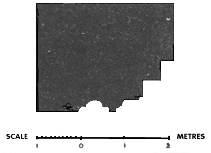
FIG. 139.—SÂMARRÂ, MOSQUE. DETAIL
OF PIER, SOUTH DOOR.
|
|
of mouldings round the inner face of the central opening (Fig. 139). The upper part of the south wall is pierced by twenty-four windows, two of them being placed over the smaller openings of the central gateway (Fig. 122). These windows, together with the trenches in the interior of the mosque which mark the line of the columns, determine the number of the collonnades; there must have been twenty-four, each one ending against the wall between the windows. The central aisle which terminated at the main gate and was wider than the rest, was not provided with a window. The space between the colonnades was undoubtedly roofed with beams; the holes into which the large crossbeams were fitted can still be seen on the inner side of the south wall. The windows, placed with regard to the aisles, bear no relation to the position of the round bastions on the exterior of the wall. They break into them at haphazard, frequently impinging upon their sides, while in one instance a window is cut straight through a tower (Fig. 120). On the inner face the windows are covered by a cusped arch (Fig. 142). The east and west walls are broken by / p.234 / numerous doors. Beginning from the southern end there is first a small entrance, 1.25 m. wide, close to the angle bastion (Fig. 141). A wall about a metre in length projects from the main wall to the south of the door opening and has been connected with the top of the main wall by a section of vaulting. Immediately beyond this postern there is a large gateway 4.55 m. wide, and then another which is still larger, being 4.75 m. wide. The next door is 3.85 m.; the fifth, which is only 2.62 m., is found in the west wall alone. Then follows another of the larger doors, about 4 metres wide, beyond which there is, in the west wall only, a door 2.62 m. wide; then on both sides a large door 4.05 m. wide and a small door 1.50 m. wide. The north wall is broken by five gates, the two at the outer ends averaging 1.50 m. and the other three 4 metres in width. All the smaller doors exhibit an exceedingly curious piece of construction (Fig. 140). The brickwork of the wall runs uninterruptedly over the door opening without the intermission of arch or lintel. It is as if the door had been cut out of the wall with a knife, and the bricks above it, so far as they keep their place, do so only by reason of the excellence of the mortar. The wall above the larger doors has in every case fallen away, but there is evidence of the former existence of some kind of lintel or arch strengthened by wooden beams, the round holes for the beams being visible in the existing masonry (Fig. 143). I incline to the theory of a lintel; the faced wall above the holes leaves no room for an arch. Above this lintel there would seem to have been a row of small arched windows two or three in number (cf. the two side openings of the south gate where there is a single window above the arch). Along the top of the east, west, and north walls runs a brickwork decoration consisting of a series of recessed squares, each of which contains the recessed segment of a sphere. The walls are seamed from top to bottom with narrow runnels, which were no doubt connected with the drainage system of the roof. There is no unanimity of opinion among those who have planned the mosque concerning the number of the colonnades in the / SÂMARRÂ p.235 / interior. As I have already said, it seems to me evident that there were twenty-four rows of columns or piers, from east to west, at the northern and southern ends of the mosque. I made out the colonnades to be ten deep upon the south side and three deep upon the north, while upon the east and west sides I counted four rows of columns.1
---------------------------
1 Viollet puts them ten deep to the south, four deep to the north and five deep to east and west.
---------------------------
The supports of the arcades must have been either columns or small piers. From the absence of any structural remains, such as might have been expected if the supports had taken the form of brick piers, I incline, with Herzfeld, to the view that the roof must have been carried on columns. Their total disappearance may possibly be accounted for by the fact that they were of wood,2
---------------------------
2 In Mansûr's mosque at Baghdâd, the roof was borne by wooden columns. See Le Strange, Baghdâd, p. 34.
---------------------------
though Mukaddasî, writing at the end of the tenth century, relates that the mosque of Sâmarrâ was built upon marble columns and his evidence cannot be wholly dismissed. In the centre of the open court was placed, in all probability, the famous stone basin called the Kâs i Fir'aun (Pharaoh's Cup), which is described by Mustaufî.3
---------------------------
3 Lands f the Eastern Califate, p. 56.
---------------------------
The minaret, with its singular spiral path, stands to the north of the mosque. The summit, though somewhat ruined, still retains a decoration of niches. There can be little doubt that the mosque is that which was erected by Mutawakkil (A.D. 847-861) to replace Mu'tamid's Friday mosque, but Yâkût asserts that the minaret is a relic of Mu'tamid's foundation, Yâkût, however, wrote in 1225 when Sâmarrâ had long been in ruins.
Next in importance to the mosque is the castle or palace on the opposite bank of the Tigris, known as the 'Ashik (Fig. 145).4
---------------------------
4 Its original name is doubtful. In the twelfth century it was called the Ma'shûk, for Ibn Jubeir alludes to it under that name in the twelfth century, and so does Ibn Batûtah in the fourteenth century.
---------------------------
The first time I visited it we crossed in a guffah from a point a little below the town where there is usually a bridge of boats. The bridge had been swept away by the floods and the guffah landing was very bad. It was a full hour's
[ p.235 ]
FIG. 145.—EL 'ASHIK. (Link)
/ SÂMARRÂ p.237 / ride up the river to El 'Ashik, but I was rewarded for my trouble by finding indubitable traces of a masonry bridge in the low ground almost exactly opposite a curious little building called Slebîyeh. My attention was called to the bridge by seeing men digging out the brick piers and arches for building material. The peasants told me that when the river is low, piers can be seen in the bed of the stream and that the bridge ran in the direction of the Beit el Khalîfah. I give this information for what it is worth. Ya'kûbî mentions a bridge of boats (ed. de Goeje, p. 263): it is not impossible that pontoons may have been thrown across the deepest and swiftest part of the river and connected with the high ground on the west bank, which is at some distance from the stream, by a series of masonry arches of which I saw the remains. The piers and arches would therefore have stood on ground which was under water in time of high flood. This is exactly the arrangement of the modern bridge at Môsul. The castle of the 'Ashik consists of a great enclosure, 123 metres from north to south and 85 metres from east to west, surrounded by a wall with round bastions which are set upon a rectangular base (Fig. 146). All the buildings that may have stood within the wall have vanished, but adjoining the north wall there are remains of a gatehouse consisting of five parallel chambers opening on to a corridor or platform. The chambers and the corridor are built upon a substructure of vaults. Under the corridor the vaults run from east to west, except in the central part where the vault running from north to south is a continuation of the vault under the central chamber. Under the five chambers all the vaults run from north to south.1
---------------------------
1 Villet has given a section of them, pl. xviii.
---------------------------
The vaults are built of flat tiles laid in slices against the head-wall without centering. They have the usual small set forward from the wall, but in one case, perhaps in more than one, there is a slight divergence from the customary arrangement. From the spring of the vault the tiles are laid horizontally for the first sixteen or seventeen courses, projecting forward so as to form a shallow curve; / p.238 / above these horizontal courses the tiles are laid upright and in slices; they form an ovoid curve more abrupt than the curve of the lower part of the vault. The fourth of the upper chambers, reckoning from east to west, is the best preserved. It shows the remains of a doorway, 1.85 m. wide, covered on the same principle as the small doors of the mosques, i.e. without lintel or arch. A moat or trench runs all round the castle and passes to the north of the gatehouse. A bridge, of which small trace remains, connected the gatehouse with a rectangular outpost. To the north and east of this outpost there are fragments of a wall and towers which encompassed a rectangular area.1
---------------------------
1 Viollet's plan, pl. xvii, is here more complete than mine.
---------------------------
The most interesting feature in the ruins is the niche decoration between the bastions of the north wall (Fig. 148). The niches have

FIG. 148.—EL 'ASHIK, DETAIL OF NICHING ON NORTH FAÇADE. |
been in part filled up — no doubt they were found to be too dangerous a weakness to the wall — but their scheme is clearly apparent (Fig. 144). Each niche consisted of a high cusped arch above a rectangular recessed panel which enclosed in turn a smaller arched niche. High up on the wall, near the western angle tower, there are traces of an upper order of niches. There is some indication that the niches were continued in the first north bay of the west wall, but the remainder of this wall, together with the whole of the east wall, is completely ruined. The disadvantage of these deep niches is evident in the fourth wall where the niche has been broken through at its weakest point and has now the appearance of a door. In the two central towers on this side there seemed to have been small flat-roofed chambers (Fig. 147). The building materials used in the castle are burnt and sun-dried brick. The foundations of the
[ Illustrations opposite p.238 ]
FIG. 146.—SÂMARRÂ, EL 'ASHIK, FROM NORTH. (enlargement)
FIG. 147.—SÂMARRÂ, EL 'ASHIK, FROM SOUTH. (enlargement)
[ Illustrations opposite p.239 ]
FIG. 150.—SÂMARRÂ, SLEBÎYEH.
FIG. 151.—SÂMARRÂ, SLEBÎYEH, SETTING OF DOME.
/ SÂMARRÂ p.239 / walls and towers, the vaulted substructures, the niched face of the north wall and its towers, together with what remains of the south wall and towers are of burnt brick, but all the rest of the structure, including the partition walls of the gatehouse, are of sun-dried brick, and the same material is used to fill up the niches in the north wall.
I rode northwards from the 'Ashik for exactly an hour to the ruins of Huweisilât where there are traces of a wall set with towers. One tower alone stood to any height; it appeared to mark the north-west corner of a rectangular
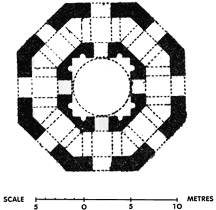
FIG. 149.—SLEBÎYEH.
|
|
enclosure, in the centre of which was a mound covered with fragments of tiles, but the east side of the enclosing wall was so completely destroyed that I could not make out the line of it. One important point is to be noted: the wall and towers were not built of brick, but of pebbles set in concrete, exactly similar to the masonry of the Kâim tower, and I think it possible that both Kâim and Huweisilât may belong to an age prior to the Abbâsid period. It must, however, be added that the gateway of the castle at Tekrît, which is undoubtedly Mohammadan, is built of the same materials. South of the 'Ashik is the ruin known as Kubbet es Slebîyeh (Fig. 149). It consists of a small square central chamber, octagonal upon the exterior, encompassed by an octagonal corridor (Fig. 150). The central chamber had been covered by a dome which was set on a simple bracket over the angles of the substructure (Fig. 151); the corridor had been barrel vaulted. Fragments of the transverse arches that helped to carry the vault are still in place. Slebîyeh was built of sun-dried brick covered with plaster.
When I went to the 'Ashik for the second time I sent a / p.240 / guffah up the river to above Lekweir and dropped downstream to the ruins of the castle, whence we floated down to the camp. On this most pleasant expedition I took occasion to examine Lekweir. It lies about an hour's ride above Sâmarrâ, and unlike all the other ruins, it is in the low ground by the water's edge. Its complete destruction is perhaps due to its having been at the mercy of the flooded river. Great blocks of fallen brickwork lie upon the bank and in the stream, while a massive brick wall forms a sort of quay. A large building must have adjoined this quay, for the ground is tossed into mounds for a considerable
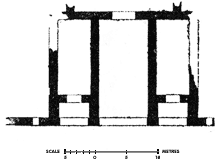
FIG. 152.—SÂMARRÂ, BEIT EL KHALÎFAH. |
|
distance and the mounds are strewn with broken brick and with fragments of thin marble slabs, pink, green and greyish-white in colour.
The only other edifice which has escaped complete destruction is the Beit el Khalifah (the House of the Khalif) (Fig. 152).
1
---------------------------
1 I give a plan of the three vaulted halls, but Viollet has made a sketch plan of the ground behind which furnishes indications of the whole scheme of the palace. The Beit el Khalîfah is perhaps the Dâr el 'Ameneh, the first palace built by Mu'taçîm upon the site of the monastery: Herzfeld, Sâmarrâ, p. 63.
---------------------------
It is a triple-vaulted hall standing above the Tigris (Fig. 153).
1
---------------------------
1 Ross distinguished in 1834 a substructure of "arches" (op. cit.., p. 129) by which he must mean vaults like those at the 'Ashik.
---------------------------
The central hall was no doubt the audience chamber of the palace; it corresponds to the great hall at Ctesiphon. The two wings are divided into a small ante-chamber, covered with a semi-dome set on squinches (Fig. 154), and a larger room roofed with a barrel vault. The vaults are all slightly pointed and all are built on the Meso-
[ Illustrations opposite p.240 ]
FIG. 153.—SÂMARRÂ, BEIT EL KHALÎFAH.
FIG. 154.—SÂMARRÂ, BEIT EL KHALÎFAH, DETAIL OF VAULT OF SIDE CHAMBER.
[ Illustrations opposite p.241 ]
FIG. 156.—SÂMARRÂ, BEIT EL KHALÎFAH, STUCCO DECORATION.
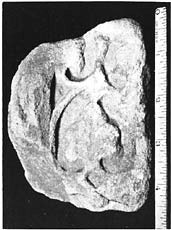
FIG. 157.—SÂMARRÂ, BEIT EL KHALÎFAH,
FRAGMENT OF RINCEAUX WORKED IN
MARBLE.
|
|
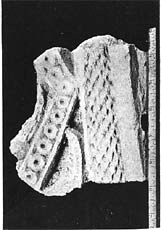
FIG. 158.—SÂMARRÂ, BEIT EL
KHALÎFAH, STUCCO DECORATION.
|
/ SÂMARRÂ p.241 / potamian system, without centering and with a small corbelling forward from the wall. Under this outset there are a series of square holes as if for beams, though it is scarcely conceivable that beams can have been laid across the halls at this point. Round wooden poles were certainly used in the body of the walls; the wood has perished leaving the round hole which it occupied. The windows (or doors?) of the chambers on either side of the triple hall were covered without lintel or arch in the manner already described. The decoration of the palace must have been mainly of stucco, worked in relief or frescoed. Lying upon the ground were small fragments of plaster bearing a frescoed pattern of a simple kind, a row of circles outlined in red and yellow; a small piece
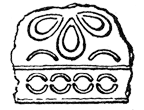
FIG. 155.—BEIT EL KHALÎ-
FAH, FRAGMENT OF STUCCO
DECORATION ON ARCH.
|
|
of moulded stucco is still attached to the inside of the arch over the opening of the central chamber (Fig. 155) and I picked up other pieces (Fig. 158). While I was at work a peasant came to me and inquired whether I would like to see a picture which he had just unearthed. I went with him to a trench close at hand, where he had been digging for bricks, and found a beautiful piece of plaster work adhering to a wall (Fig. 156). It was doomed to instant destruction that the bricks behind it might be removed. I inquired whether such decorations were frequently discovered, and promised a reward for any piece that was brought to me, with the result that before I left I had been provided with four other examples. Three showed variants of a continuous pattern (Figs. 159 and 160), while the third was worked with a fret motive (Fig. 161). To the east of the triple hall there are some underground chambers hollowed out of the rock. They have been explained in various manners and fully described by Viollet. Here as elsewhere in Sâmarrâ the rock begins immediately below the surface of the ground. It is a conglomerate of pebbles in a bed of lime, exceedingly hard to work and covered with so thin a layer of earth that / p.242 / no cultivation is possible. The cornfields and vineyards of the Abbâsid Sâmarrâ lay on the opposite bank of the Tigris in the low alluvial soil beneath the ridge on which stand Huweisilât, the 'Ashik and Slebîyeh. Near the underground chambers of the Beit el Khalîfah there are considerable mounds, and in some places fragments of building which appertained to the palace. The walls are of sun-dried brick
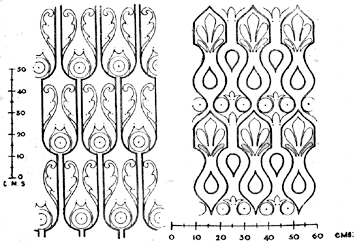
FIG. 159.—STUCCO DECORATIONS, SÂMARRÂ. |
and the rooms have been covered with domes and semi-domes resting on squinch arches.
Almost due east of the Beit el Khalîfah there rises out of the middle of the plain a large artificial mound, Tell 'Alîj.1
---------------------------
1 An account of it, together with a sketch plan, was given by Ross, op. cit., p. 130.
---------------------------
It is surrounded by a moat, and beyond the moat there are traces of a circular wall. A little to the east of north a raised causeway leads down from the top of the tell, crosses the moat by what must once have been a bridge and runs straight as an arrow over the space between moat and wall
[ Illustrations opposite p.242 ]
FIG. 160.—SÂMARRÂ, STUCCO DECORATION.
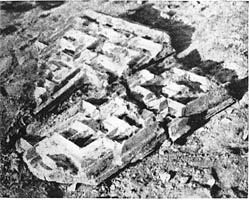
FIG. 161.—SÂMARRÂ, STUCCO DECORATION.
|
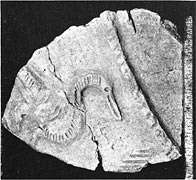
FIG. 162.—SÂMARRÂ, FRAGMENT OF
POTTERY.
|
FIG. 163.—SÂMARRÂ, FRAGMENT OF POTTERY.
[ Illustrations opposite p.243 ]
FIG. 165.—ABU DULÂF, ARCADE.
FIG. 166.—ABU DULÂF, NICHED PIER OF NORTHERN ARCADE.
/ SÂMARRÂ p.243 / (Ross made it 110 paces) and across the plain for about half-a-mile. It ends at a low mound where Ross found remains of brickwork. On either side of the point where the causeway reaches the outer edge of the ditch, a low mound, fanning out from the causeway, stretches from ditch to rampart. These mounds are the remains of walls that protected the causeway. Local tradition says that the moat was fed with water by a canal from the Tigris; Ross adds that the kanât, or cut as he calls it, brought water from a channel (he uses the word tunnel, by which he probably means kanât, underground conduit) which ran from the Jebel Hamrîn to Sâmarrâ. What this singular fortified mound can be I do not know, but I should be surprised if it did not belong to a period earlier than the days of the Abbâsids.
All the area of the city is strewn with Mohammadan pot-sherds, but the pottery is markedly different in character from that of Rakkah. Coloured ware, though it is not entirely absent, is rare; by far the greater number of pieces are unglazed and ornamented only with incised patterns which are frequently divided into zones by raised notched bands. I saw, too, a few fragments of a better class of pottery with beautiful patterns or inscriptions in relief, worked with the utmost care. When the peasants discovered that the patterned clay excited my interest they brought basket loads of broken pots to my tents and I drew and photographed innumerable examples, two of which I here reproduce (Figs. 162 and 163).
In the mosque of Abu Dulâf (Fig. 164)
1
---------------------------
1 Viollet has given a plan of Abu Dulâf. Herzfeld did not publish it in his Sâmarrâ, for he had not at that time visited it, but he has since published a plan : Zeitschr. für Gesch. der Erkunde zu Berlin, 1909, No. 7, pl. viii. My plan differs considerably from his, but only a re-examination of the mosque can prove which of us is right.
---------------------------
the arcades are carried on massive brick piers and the effect of the long, half-ruined aisles is very imposing (Fig. 165). The area embraced by the outer wall of sun-dired brick is slightly smaller than at Sâmarrâ (213.20 x 136.50 m.) and the arcades are more widely spaced, but the type of plan is the same, even to the spiral minaret to the north. Although the enclosing wall is no better than a crumbling mound, it is possible to make out the
/ p. 244 /
FIG. 164.—ABU DULÂF. (Link)
/ SÂMARRÂ p.245 / gateways, inasmuch as the jambs, which were built of burnt brick, stand more or less intact. The arcades and their returns against the wall are also of burnt brick, and so are the remains of the three bastions which are all that can be seen in the south wall. In the centre of this wall there is another fragment of burnt brick which might be the curve of a mihrâb but is more probably a door leading into a small building or vestibule,1
---------------------------
1 This vestibule is present opposite the south gate of the Sâmarrâ mosque. Herzfeld has made an attempt to reconstruct the vestibule of Abu Dulâf. Viollet has given a bare indication of it, and this is all that exists. Viollet has also marked the line of an outer wall, which, as at Sâmarrâ, enclosed the precincts of the mosque.
---------------------------
of which the shapeless mounds can be distinguished immediately to the south of the wall. There is a space of 10.40 m. between the outer wall and the southernmost row of piers, and the ruins give no indication of its having been roofed over. But if this transept were open to the sky it is unlikely that the mihrâb should have been placed in it, and I should therefore place a door in the centre of the south wall as at Sâmarrâ. The space between the arcades at the norhtern and southern ends of the mosque averages 6.20 m., but the alley which conducts to the central door at either end measures 7.33 m. in width. Similarly the alley conducting to the central doors leading into the court from east and west is 4.90 m. wide, whereas the average width of the intercolumniation of the east and west arcades is 4.15 m. The plan exhibits everywhere noticeable irregularities; the arcades vary in width, sometimes by as much as ten centimetres. The small piers in the haram average 2.10 x 1.73 m., the greater length being from north to south. The piers of the arcades to east and west of the sahn average 4.03 x 1.57 m.; the small piers of the northern arcades 2.18 x 1.57 m.; the small piers of the northern arcades 2.18 x 1.52 m. All the piers bordering the central court are adorned upon the face which is turned towards the court with a brick niche covered with a cusped arch and placed high up on the pier (Fig. 166). There is also a decoration of small niches upon the north side of the base of the minaret; the other sides are too much ruined to have retained the trace of it. The north wall of the mosque / p.246 / is the best preserved, and shows in places the same drainage runnels that were described at Sâmarrâ.
The ruins of which I have here given a brief account are of the first importance for the elucidation of the early history of the arts of Islâm. They can all be dated within a period of forty years falling in the middle of the ninth century, and are therefore among the earliest existing examples of Mohammadan architecture. They bear witness to the Mesopotamian influences under which it arose. The spiral towers of Sâmarrâ and Abu Dulâf1
---------------------------
1 Abu Dulâf was probably built by Mutawakkil when he erected a whole new quarter three farsakhs north of Shnâs : Ya'kûbî, ed. de Goeje, p. 266.
---------------------------
are an adaptation of the temple pyramids of Assyria and Babylonia which had a spiral path leading to the summit; the technique of arch and vault was invented by the ancient East and transmitted through Sassanian builders to the Arab invaders; the decoration is Persian or Mesopotamian and almost untouched by the genius of the West.2
---------------------------
2 The spiral tower occurs also in Sassanian architecture, witness the Atesh Gah of Jur, Dieulafoy : L'Art ancien de la Perse, Vol. IV. p. 79.
---------------------------
In the palaces and mosques of Sâmarrâ, we can see the conquerors themselves conquered by a culture which had been developing during thousands of years on Mesopotamian soil, a culture which had received indeed new elements into its composition, which had learnt from the Greek and from the Persian, but had maintained in spite of all modifications its distinctive character. Side by side with Sâmarrâ stand the ruins at Rakkah, where the mosque repaired by Nûr ed Dîn probably preserves a plan which can be dated even earlier than the two mosques on the Tigris; and finally the scheme and decoration of the Mesopotamian mosque is reproduced with certain variations in the latter half of the ninth century by Ibn Tûlûn, and the last descendant of the Babylonian zigurrat is the minaret of his mosque at Cairo.3
---------------------------
3 Thiersch has indicated the true relation of Ibn Tûlûn's minaret both to the zigurrat of Mesopotamia and to the pharos of Alexandria. His objections to Herzfeld's theory that the Cairo minaret is purely Hellenistic in origin are conclusive. Thiersch : Pharos, p. 112.
---------------------------

